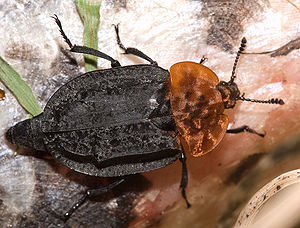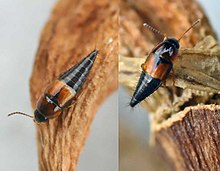Staphylinoidea
| Staphylinoidea | ||||||||||||
|---|---|---|---|---|---|---|---|---|---|---|---|---|

Red-necked Silphe ( Oiceoptoma thoracicum ) |
||||||||||||
| Systematics | ||||||||||||
|
||||||||||||
| Scientific name | ||||||||||||
| Staphylinoidea | ||||||||||||
| Latreille , 1802 |

The Staphylinoidea are a superfamily of the Polyphaga from the order of the beetles (Coleoptera). They are represented worldwide and comprise seven families with more than 58,000 species. By far the most species-rich family of this group are the short-winged species (Staphylinidae) with more than 48,000 described species.
features
The delimitation of this superfamily is based on a concept by Hansen (1997) based on nine suspected autapomorphies : the pronotum is missing the ridge below the rear edge as a locking mechanism; on the ventral side of the elytra (elytra) lacks the medio-lateral connecting region (binding patch); the hind wings lack the apical hinge distal to the radial cell; the hind wings do not have a medial loop; the hind wings have only one wing vein in front of the "medial bar"; the basal part of the aedeagus is absent (membranous); In the larvae the tenth abdomen segment on the invertible anal lobe is covered with numerous fine teeth; the larvae do not have a frontoclypeal suture on the head and the urogomphi are trained, bipartite and mobile. It is also possible that the presence of only four instead of six Malpighian vessels is an autapomorphism, although the dwarf beetles (Ptiliidae) only have two.
Taxonomy and systematics
Some of the autapomorphies are doubtful - for example the lack of the frontoclypeal suture in the larvae, which is also missing in many other taxa, or the motile urogomphi, which also occur in the larvae of most species of the Adephaga , Hydrophiloidea and Histeroidea - the monophyly of the Staphylinoidea however, it is well founded, particularly because of the characteristics of the wings.
Within the superfamily there are two major kinship lines. The "ptiliide" line, the ptiliidae (Ptiliidae) and hydraenidae is (Hydraenidae), and justified by 12 autapomorphies, and the "staphylinide" line, the families of the rove beetles (Staphylinidae), carrion beetles (Silphidae) and scydmaenidae ( Scydmaenidae) and is based on at least 17 autapomorphies. As the relationships of these two groups to the remaining two families of sponge ball beetle (leiodidae) and Scheinaaskäfer represent (Agyrtidae) is not yet fully understood. Either the two families form a third line, the “leiodide” line, and are a sister group of the “staphylinid” line, or the sponge ball beetles are most closely related to the “ptiliiden” line and in turn form a sister group to the pseudo beetles.
The Staphylinoidea includes the following families:
- Long- button water beetles (Hydraenidae), approx. 1300 species
- Dwarf beetles or feather-winged beetles (Ptiliidae), approx. 550 species
- Scheinaaskäfer (Agyrtidae), more than 60 species
- Leiodidae , approx. 3460 species
- Ant beetle (Scydmaenidae), approx. 4600 species
- Carrion beetles (Silphidae), approx. 200 species
- Kurzflügler (Staphylinidae), approx. 48,000 species
supporting documents
Individual evidence
- ↑ a b c d e Rolf G. Beutel, Richard AB Leschen: Handbuch der Zoologie - Coleoptera, Beetles, Volume 1: Morphology and Systematics (Archostemata, Adephaga, Myxophaga, Polyphaga partim) . 1st edition. de Gruyter , 2005, ISBN 3-11-017130-9 , p. 223 f . (English).
- ↑ AA Polilov (2005): Anatomy of the feather-winged beetles Acrotrichis montandoni and Ptilium myrmecophilum (Coleoptera, Ptiliidae). Entomological Review 85 (5): 467-475.
literature
- Rolf G. Beutel, Richard AB Leschen: Handbuch der Zoologie - Coleoptera, Beetles, Volume 1: Morphology and Systematics (Archostemata, Adephaga, Myxophaga, Polyphaga partim) . 1st edition. de Gruyter , 2005, ISBN 3-11-017130-9 (English).